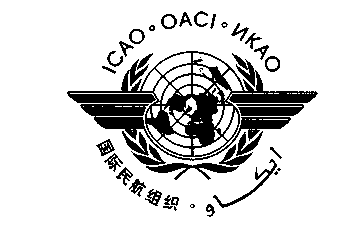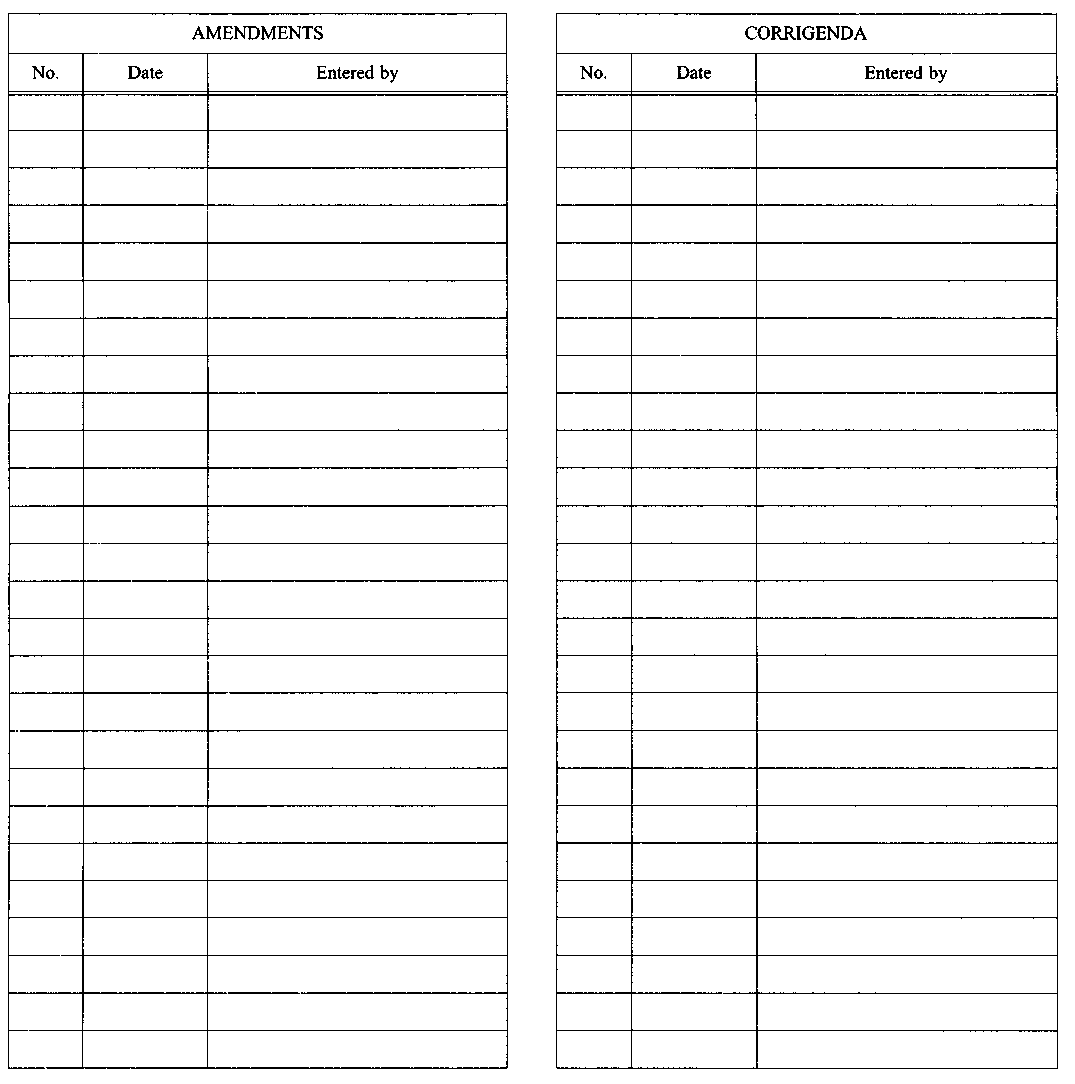
- •Amendments
- •Record of amendments and corrigenda
- •Foreword
- •Table of contents
- •Chapter 1 glossary
- •1.1 Definitions of principal terms used in this manual
- •1 .2 Commonly used abbreviations
- •1.3 Explanation of scenario
- •T able 1
- •Chapter 2 general operating procedures
- •2.1 Introduction
- •2.2 Transmitting technique
- •2.3 Transmission of letters
- •2.4 Transmission of numbers
- •2 .5 Transmission of time
- •0 920 (9:20 A.M.) too ze-ro or ze-ro nin-erToo ze-ro 1643 (4:43 p.M.) fow-er tree or wun six fow-er tree
- •2 .6 Standard words and phrases
- •2 .7 Call signs
- •2.7.1 Call signs for aeronautical stations
- •2.7.2 Aircraft call signs
- •2.8 Communications
- •2.8.1 Establishment and continuation of communications
- •2 .8.2 Transfer of communications
- •2 .8.3 Issue of clearance and read-back requirements
- •2 .8.4 Test procedures
- •Chapter 3 general phraseology
- •3.1 Introduction
- •3.2 An explanation of the role of phraseologies and plain language in radiotelephony communications
- •3.3 Level instructions
- •3 .4 Position reporting
- •3 .5 Flight plans
- •Vicinity of kennington
- •Chapter 4 aerodrome control: aircraft
- •4.1 Introduction
- •4.2 Departure information and engine starting procedures
- •4 .3 Push-back
- •4.4 Taxi instructions
- •4 .5 Take-off procedures
- •Immediately or hold
- •Immediately fastair 345
- •4 .6 Aerodrome traffic circuit
- •2 500 Feet information bravo, for landing
- •4 .7 Final approach and landing
- •4 .8 Go around
- •4 .9 After landing
- •4 .10 Essential aerodrome information
- •F astair 345 caution construction work adjacent to gate 37
- •Chapter 5 aerodrome control: vehicles
- •5.1 Introduction
- •5.2 Movement instructions
- •5 .3 Crossing runways
- •V acated
- •5 .4 Vehicles towing aircraft
- •Chapter 6 general radar phraseology
- •6.1 Introduction
- •6.2 Radar identification and vectoring
- •6 .3 Radar vectoring
- •6 .4 Traffic information and avoiding action
- •6 .5 Secondary surveillance radar
- •6 .6 Radar assistance to aircraft with radiocommunications failure
- •6.7 Alerting phraseologies
- •12 O'clock 4 miles
- •Chapter 7 approach control
- •7.1 Ifr departures
- •7 .2 Vfr departures
- •7 .3 Ifr arrivals
- •7.4 Vfr arrivals
- •7 .5 Radar vectors to final approach
- •345 Heavy fl 60 approaching north
- •7 .6 Surveillance radar approach
- •4% Miles from touchdown altitude
- •2 1/2 Miles from touchdown altitude
- •7 .7 Precision radar approach
- •1/4 Mile from touchdown approach completed
- •Chapter 8 area control
- •8.1 Area control units
- •8 .2 Position information
- •8 .3 Level information
- •8 .4 Flights joining airways
- •8 .5 Flights leaving airways
- •8 .6 Flights crossing airways
- •8 .7 Flights holding en route
- •20 Minutes
- •8 .8 Radar
- •8 .9 Automatic dependent surveillance (ads)
- •8 .10 Oceanic control
- •Chapter 9
- •9.1 Introduction
- •9.2 Distress messages
- •9.2.1 Aircraft in distress
- •20 Miles south of walden. Passing 3 000 feet
- •9.2.2 Imposition of silence
- •9 .2.3 Termination of distress and silence
- •9 .3 Urgency messages
- •2 000 Feet heading 190
- •9.4 Emergency descent
- •9 .5 Aircraft communications failure
- •Chapter 10
- •10.1 Introduction
- •1 0.2 Runway visual range (rvr)
- •650 Metres 700 metres
- •1 0.3 Runway surface conditions
- •500 Feet due broken
- •Chapter 11 miscellaneous flight handling
- •11.1 Selective calling (selcal)
- •11.2 Fuel dumping
- •10 Miles ahead of the aircraft and
- •1 1.3 Wake turbulence
- •11.4 Wind shear
- •1 1.5 Direction finding
- •11.6 Acas manoeuvres
D oc
9432
oc
9432
AN/925
Manual of Radiotelephony
Approved by the Secretary General and published under his authority
Third Edition — 2006
International Civil Aviation Organization
Amendments
The issue of amendments is announced regularly in the ICAO Journal and in the monthly Supplement to the Catalogue of ICAO Publications and Audio-visual Training Aids, which holders of this publication should consult. The space below is provided to keep a record of such amendments.
Record of amendments and corrigenda

(ii)
Foreword
ICAO phraseologies are contained in procedures found in Annex 10 — Aeronautical Telecommunications, Volume II — Communication Procedures including those with PANS status and in the Procedures for Air Navigation Services —Air Traffic Management (PANS-ATM, Doc 4444). The purpose of this manual is to provide examples of the radiotelephony phraseology found in those two documents. While the procedures and phraseology specifically reflect the situation in an environment where very high frequency (VHF) is in use, they are equally applicable in those areas where high frequency (HF) is used.
ICAO phraseologies are developed to provide efficient, clear, concise, and unambiguous communications, and constant attention should be given to the correct use of ICAO phraseologies in all instances in which they are applicable. However, it is not possible to provide phraseologies to cover every conceivable situation which may arise, and the examples contained in this manual are not exhaustive, but merely representative of radiotelephony phraseology in common use. Users may find it necessary to supplement phraseologies with the use of "plain" language. When it is necessary to use plain language, it should be used according to the same principles that govern the development of phraseologies in that communications should be clear, concise, and unambiguous. Sufficient proficiency in the language being used is also required. (ICAO language proficiency requirements are found in ICAO Annex 10, Volume II and Annex 1 — Personnel Licensing.) In addition to correct use of phraseologies and adequate language proficiency, it is also important to keep in mind that the language being used in radiotelephony is often not the first language of the receiver or originator of a transmission. An awareness of the special difficulties faced by second-language speakers contributes to safer communications. Transmissions should be slow and clear. Direct statements which avoid idiomatic expressions are easier to understand than indirect statements or colloquialisms or slang.
Furthermore, certain States may specify in their aeronautical information publication (AIP) particular requirements on first contact when entering their airspace or prior to leaving their airspace. Pilots should, therefore, ensure that they are aware of such procedures by referring to the relevant instructions (e.g. AIP and NOTAM) before undertaking international flights. Examples of phraseology of this type are beyond the scope of this manual.
(iii)
Table of contents
Page
CHAPTER 1 — Glossary 1-1
Definitions of principal terms used in this manual 1-1
Commonly used abbreviations 1-4
Explanation of scenario 1-6
CHAPTER 2 — General operating procedures 2-1
Introduction 2-1
Transmitting technique 2-1
Transmission of letters 2-2
Transmission of numbers 2-3
Transmission of time 2-6
Standard words and phrases 2-6
Call signs 2-8
Call signs for aeronautical stations 2-8
Aircraft call signs 2-9
2.8 Communications 2-10
Establishment and continuation of communications 2-10
Transfer of communications 2-12
Issue of clearance and read-back requirements 2-13
Test procedures 2-15
CHAPTER 3 — General phraseology 3-1
Introduction 3-1
An explanation of the role of phraseologies and plain language in radiotelephony communications 3-1
Level instructions 3-2
Position reporting 3-4
Flight plans 3-5
CHAPTER 4 — Aerodrome control: aircraft 4-1
Introduction 4-1
Departure information and engine starting procedures 4-1
Push-back 4-2
Taxi instructions 4-3
Take-off procedures 4-6
Aerodrome traffic circuit 4-9
Final approach and landing 4-13
Go around 4-14
After landing 4-15
Essential aerodrome information 4-16
(V)
(vi) Manual of Radiotelephony
P age
age
CHAPTER 5 — Aerodrome control: vehicles 5-1
Introduction 5-1
Movement instructions 5-1
Crossing runways 5-3
Vehicles towing aircraft 5-4
CHAPTER 6 — General radar phraseology 6-1
Introduction 6-1
Radar identification and vectoring 6-1
Radar vectoring 6-2
Traffic information and avoiding action 6-4
Secondary surveillance radar 6-5
Radar assistance to aircraft with radiocommunications failure 6-6
Alerting phraseologies 6-7
CHAPTER 7 — Approach control 7-1
IFR departures 7-1
VFR departures 7-1
IFR arrivals 7-2
VFR arrivals 7-6
Radar vectors to final approach 7-7
Surveillance radar approach 7-8
Precision radar approach 7-12
CHAPTER 8 — Area control 8-1
Area control units 8-1
Position information 8-2
Level information 8-3
Flights joining airways 8-4
Flights leaving airways 8-6
Flights crossing airways 8-6
Flights holding en route 8-6
Radar 8-7
Automatic Dependent Surveillance (ADS) 8-8
Oceanic control 8-8
CHAPTER 9 — Distress and urgency procedures and communications failure procedures 9-1
Introduction 9-1
Distress messages 9-2
Aircraft in distress 9-2
Imposition of silence 9-3
Termination of distress and silence 9-3
Urgency messages 9-4
Emergency descent 9-5
Aircraft communications failure 9-6
Table of Contents (vii)
P age
CHAPTER 10 — Transmission of meteorological and other aerodrome information 10-1
Introduction 10-1
Runway Visual Range (RVR) 10-1
Runway surface conditions 10-2
CHAPTER 11 — Miscellaneous flight handling 11-1
Selective Calling (SELCAL) 11-1
Fuel dumping 11-2
Wake turbulence 11-2
Wind shear 11-3
Direction finding 11-3
ACAS manoeuvres 11-4
